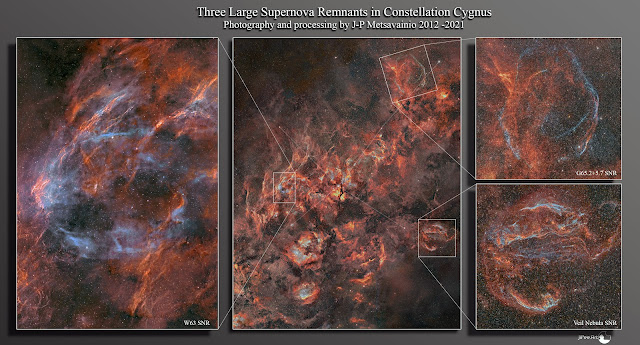COPYRIGHT, PLEASE NOTE
Sunday, October 26, 2025
ICARUS, a two frame vertical panorama
In this image, I have combined my new shot of the Witch’s Broom Nebula with my recent photo “ICARUS, the Final Flight” to form a two-frame mosaic. I love discovering fresh compositions from well-known targets — in this case, the beautiful Veil Nebula supernova remnant.
Click for a large image, 1500 x 3600 pixels
Click for a large image, 2000 x 2500 pixels
The area of interest is marked as a white rectangle
O-III, 9x 1200 s, binned 1x1 = 16h
Friday, October 24, 2025
ICARUS, the final flight
My latest photo shows a small portion of the Veil Nebula supernova remnant in Cygnus. I have wanted to photograph this tiny, knot-like object for a long time, making it the main character of the composition. I couldn’t find any catalog number for this object — if someone knows it, please drop a comment and I’ll add it here.
After I stacked all the data and saw the full-resolution image for the first time, I had the strange feeling that I had seen this composition before. A moment later I realised what it reminded me of — an old painting of Icarus from Greek mythology.
Click for a large image, 1600 x 2000 pixels
This is how I saw it in my head
Click for a large image, 1600 x 2000 pixels
The area of interest is marked as a white rectangle
O-III, 9x 1200 s, binned 1x1 = 3h
Tuesday, October 14, 2025
Western Veil nebula, the Witch's Broom
This is my first-light image for the autumn season 2025.
I collected a total of 34 hours of exposure time over a period of about two months for this two-frame mosaic. The seeing conditions were relatively good for my location, with FWHM values ranging between 1.6 and 2.5 throughout the sessions.
Witch's Broom Nebula
Click for a large image, 3500 x 1800 pixels
 A mapped color image from a light emitted by an ionized elements, sulfur=red, hydrogen=green and oxygen=blue. The resolution of the photo is reduced for the web usage.
A mapped color image from a light emitted by an ionized elements, sulfur=red, hydrogen=green and oxygen=blue. The resolution of the photo is reduced for the web usage.Witch's Broom Nebula, O-III emission alone
Click for a large image, 3500 x 1800 pixels
The Veil Nebula supernova remnant in constellation Cygnus.
The area of interest is marked as a white rectangle
Technical details
O-III, 6x 1200 s, binned 1x1 = 13
Thursday, February 6, 2025
Pickering's Triangle, Resurrection
This is not exactly a new image of Pickering's Triangle, but it is a completely new revision of it. I have photographed this complex-looking region of the Veil Nebula supernova remnant in Cygnus multiple times over the decades. In this latest revision, I have gathered all my exposures of the target and combined them into a new, most detailed version yet.
PICKERING'S TRIANGLE RESURRECTION
Click for a full size, 2700x2300 pixels
sulfur=red, hydrogen=green and oxygen=blue
Click for a full size, 2000x2000 pixels
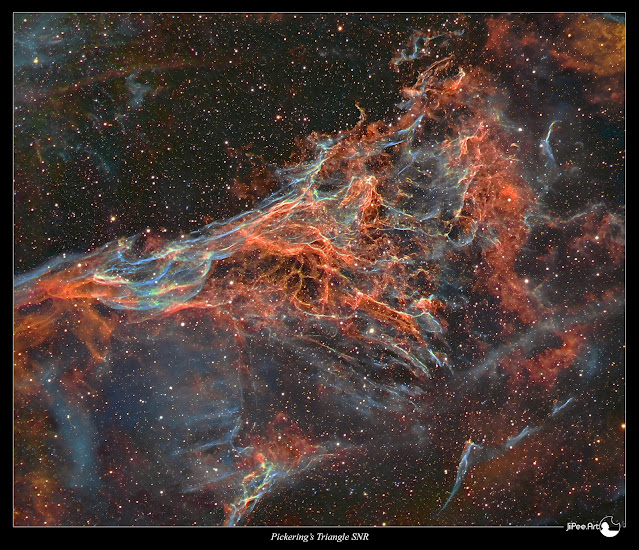
Visual color version of Sh2-115 glows mostly in red from a light emitted by an ionized elements,
sulfur=red, hydrogen=red and oxygen=blue, this combination is very close to a natural color palette
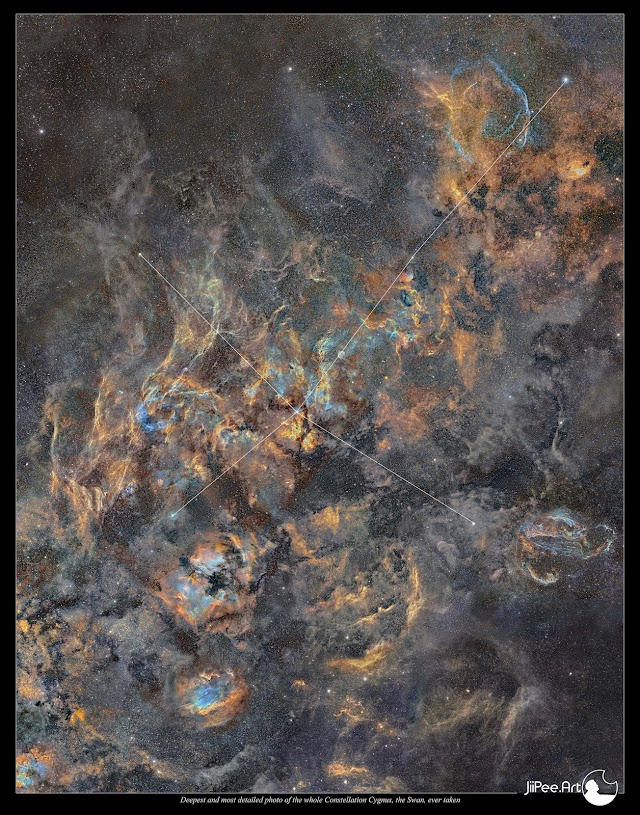 This massive mosaic, composed of over 300 panels and around 700 hours of exposure time, showcases the entire constellation of Cygnus, the Swan. The Veil Nebula supernova remnant, including Pickering's Triangle, is visible in the lower right area, slightly off-center. Additionally, two more supernova remnants appear in the image: G65.2+5.7 SNR in the upper right corner and W63, located slightly left of center, seen as a bluish ring formation.
This massive mosaic, composed of over 300 panels and around 700 hours of exposure time, showcases the entire constellation of Cygnus, the Swan. The Veil Nebula supernova remnant, including Pickering's Triangle, is visible in the lower right area, slightly off-center. Additionally, two more supernova remnants appear in the image: G65.2+5.7 SNR in the upper right corner and W63, located slightly left of center, seen as a bluish ring formation.Link to the my blog post about this massive photo:
https://astroanarchy.blogspot.com/2021/12/cygnus-mosaic-gets-large.html
This new revision of Pickering's Triangle has a cumulative exposure time of approximately 70 hours. I have compiled all the long focal length data I captured over the years into this single deep image. Various optical configurations and focal lengths were used during this time.
Some of the data was captured using my old MEADE LX200 GPS with a 0.63 focal reducer, a QHY9 camera, and a Baader narrowband filter set. Data from 2015 to 2023 was acquired with a Celestron EDGE HD 11" telescope, an Apogee Alta U16 camera, and an Astrodon narrowband filter set. The most recent data, captured in 2024, was taken with a Celestron EDGE HD 14" telescope, an Apogee Alta U9000M camera, and an Astrodon narrowband filter set. There is also some dimm background data shot with Tokina AT-x 300mm f2.8 camera optics.
Wednesday, December 21, 2022
Milky Way, 12 years, 1250 hours of exposures and 125 x 22 degrees of sky
https://astroanarchy.zenfolio.com/
It took nearly twelve years to collect enough data for this high resolution gigapixel class mosaic image of the Milky Way. Total exposure time used is around 1250 hours between 2009 and 2021.
" I can hear music in this composition, from the high sounds of sparcs and bubbles at left all the way to a deep and massive sounds at right."
The final photo is about 100 000 pixels wide, it has 234 individual mosaic panels stitched together and 1,7 gigapixels. (Click for a large image) All the frames used are marked in this image. Since many of sub-images and mosaics are independent artworks it leads to a very complex mosaic structure.
NEW, A HD-video from Germany shows my photo in full glory
https://www.youtube.com/watch?v=D-Z60eZ4yqM
(Video in Germany but images are the international language)
Close ups form the parts of the Grande Mosaic
The California Nebula, NGC 1499, can be seen at bottom left of the large mosaic image.
There are about 20 million individual stars visible in the whole mosaic image.
Click for a large image
Image spans 125 x 22 degrees of the Milky About 20 million individual stars are visible in my photo!
My processing workflow is very constant so very little tweaking was needed between the mosaic frames. Total exposure time is over 1250 hours. Some of the frames has more exposure time, than others. There are some extremely dim objects clearly visible in this composition, like a extremely dim supernova remnant W63, the Cygnus Shell. It lays about six degrees up from North America nebula and it can be seen as a pale blue ring. I spent about 100 hours for this SNR alone. An other large and faint supernova remnant in Cygnus can be seen at near right edge of the image. G65.5+5.7 is as large as more famous Veil nebula. There are over 60 exposure hours for this SNR alone. (Veil SNR is just outside of the mosaic area for compositional reasons but can be seen in "Detail" image above.)
I took my current toolset as a base tool since it has a relatively high resolution combined to a very large field of view. Also it collects photons very quickly since it's undersampled and I can have very dim background nebulosity visible in very short time (many times 30 min frame is enough)
I do all my mosaic work under the PhotoShop, Matching the separate panels by using stars as an indicator is kind of straight forward work. My processing has become so constant, that very little tweaking is needed between separate frames, just some minor levels, curves and color balance.
I have used lots of longer focal length sub-frames in my mosaic to boost details. (See the mosaic map at top of the page) To match them with shorter focal length shots I developed a new method.
Firstly I upscale the short focal length frames about 25% to have more room for high resolution images.Then I match the high res photo to a mosaic by using the stars as an indicator. After that I remove all the tiny stars from the high res image. Next I separate stars from low res photo and merge the starless high res data to a starless low res frame. And finally I place the removed low res stars back at top of everything with zero data lost. Usually there are some optical distortions and it's seen especially in a star field. Now all my stars are coming from a same optical setup and I don't have any problems with distortions. (I'm using the same star removal technique as in my Tone Mapping Workflow)
Click for a large image
Click for a large image,
IC 405 6 410 area
The blog post with technical details can be seen here, https://astroanarchy.blogspot.com/2020/10/the-tulip-nebula-in-cygnus-sh2-101.html
Wednesday, January 5, 2022
Cygnus Mosaic in Visual Colors
Three Musketeers of Swan
There are three large supernova remnants visible in this image. The Veil nebula is the most bright of them, other two are really dim and diffused. I spent about 200 exposure hours for those two alone to show them well. I call this trio to the Three musketeers.
I like the new composition, it's very dynamic and shows the whole constellation Cygnus first time ever at this detail level and deepness. I haven't seen anything like this before. Image spans now 31 x 23 degrees of sky and has 118 individual frames in it. total exposure time is now around 700 hours and the resolution 20.000 x 25.500 pixels. Image it took over a decade to finalize this photo between 2010 and 2021.
The mapped color version of this mosaic can be seen here, https://astroanarchy.blogspot.com/2021/12/cygnus-mosaic-gets-large.html
Click for a large image
Click for a large image
Beside three supernova remnants there are two Wolf Rayet stars with outer shell formations. NGC 6888, the Crescent Nebula at center of the image and the WR 134, it can be seen as a blue arch just right from the Crescent Nebula, near the Tulip nebula.
Next to the Tulip Nebula lays a Black hole Cygnus X-1
Constellation Cygnus is an endless source of celestial wonders, both scientifically and aesthetically. For me, as an visual artist, this are of night sky is very inspiring There are endless amount of amazing shapes and structures, I can spend rest of my life just shooting images from this treasury.
Monday, December 20, 2021
Cygnus mosaic gets large
The Deepest and Most Detailed Image of the Entire Cygnus Constellation Ever Captured
This new composition is designed to frame the Veil Nebula supernova remnant within the field of view.
In this image, three large supernova remnants are visible. The Veil Nebula is the brightest among them, while the other two are extremely faint and diffuse. To make these two remnants more visible, I dedicated approximately 200 hours of exposure time to capturing them alone. I like to call this trio The Three Musketeers.
I’m particularly pleased with this new composition—it’s dynamic and, for the first time, showcases the entire Cygnus constellation at this level of detail and depth. At least, I haven’t seen anything quite like it before. The image spans 31 × 23 degrees of the sky and is composed of 118 individual frames. The total exposure time is around 700 hours, and the final resolution is an impressive 20,000 × 25,500 pixels. This photograph was over a decade in the making, from 2010 to 2021.
The previous version of this mosaic can be seen here: Great Mosaic of Cygnus.
Three large supernova remnants in the same field of view
Click for a large image
ZOOMABLE VERSION
Click for a large image

Three large supernova remnants in constellation Cygnus, the Swan, are in image as colored circles
NOTE, there is an apparent size of the Moon as a scale at lower right corner in a grayscale image.
INFO
Three Supernova Remnants, Two Wolf-Rayet Stars, and a Black Hole
In the orientation image above, three large supernova remnants are visible. The first is the Cygnus Shell (W63), a bluish ring located toward the middle left. The second is the large supernova remnant (SNR) G65.3+5.7, positioned in the upper right. The third is the brightest of the three, the Veil Nebula, found along the right edge of the image.
Beyond these supernova remnants, two Wolf-Rayet stars with outer shell formations can be seen. The first is NGC 6888, the Crescent Nebula, located at the center of the image. The second is WR 134, appearing as a blue arc just to the right of the Crescent Nebula, near the Tulip Nebula.
Next to the Tulip Nebula lies the black hole Cygnus X-1. It is marked in a small close-up of the Tulip Nebula, positioned in the center-right section of the orientation image above.
The Cygnus constellation is an endless source of celestial wonders, both scientifically and artistically. As a visual artist, I find this region of the night sky incredibly inspiring. Its intricate structures and mesmerizing shapes captivate me—I could easily spend a lifetime capturing images of this cosmic treasury.
Equipment Used
Over the years, I have employed multiple optical configurations to assemble this mosaic image. Until 2014, I worked with an old Meade LX200 GPS 12" telescope, a QHY9 astro camera, Canon EF 200mm f/1.8 camera optics, and a Baader narrowband filter set.
Since 2014, I have been using a 10Micron 1000 equatorial mount, an Apogee Alta U16 astro camera, a Tokina AT-X 200mm f/2.8 camera lens, and an Astrodon 50mm square narrowband filter set.
Additionally, I have captured many detailed images using longer focal lengths. Before 2014, I used the Meade 12" scope with a reducer, and after 2014, I switched to a Celestron EDGE 11" with a reducer. My guiding cameras have included the Lodestar and, later, the Lodestar II
Thursday, October 7, 2021
Filaments of Veil in mapped colors
I shot most of the lights for this image back in 2016, now I have added some new material to it and reprocessed the whole image. A version in visual color palette can be seen here, https://astroanarchy.blogspot.com/2021/09/filaments-of-veil-nebula-snr.html
Photo was shot with a Celestron Edge HD 11" telescope, Astrodon naarrow band filters and Apogee Alta U16 astro camera. New data is shot with a shorter focal length instrument, Tokina AT-x 300mm f2.8 camera lens, same camera and filters. Dim background emission is taken from a new material and added to this photo.
Total exposure time is now 44 hours for the whole three frame mosaic and the resolution is 11.000 x 4000 pixels.
Click for a large image
Every single pixel in this 3d-animation is from the original 2D-image above. The model is based on on known scientific facts, deduction and some artistic creativity. The result is an appraised simulation of reality. Astronomical photos are showing objects as paintings on a canvas, totally flat. In reality, they are three dimensional forms floating in three dimensional space. The purpose of my 3d-experiments is to show that and Give an idea, how those distant objects might look in reality.
Wednesday, October 6, 2021
Unveiling The Veiled
The Veil nebula supernova remnant in Cygnus. Original image was shot with the Canon EF 200 mm f1.8 camera optics full open, QHY9 astro camera and Baader narrowband filters at 2013.
New data is shot with Tokina 300mm f2.8 camera optics and Celestron Edge HD 11" telescope, Apogee Alta U16 astro camera with Astrodon narrowband filters between 2016 - 2020
Total exposure time is now about 45 hours.
The Veil nebula @SuperRare auction
Animation, https://superrare.com/artwork-v2/unveiling-the-veiled-volume-29145
Photo, https://superrare.com/artwork-v2/unveiling-the-veiled-29137
Veil nebula Unveiled
Click for a large image, 1250 x 1700 pixels
Nebula in visual colors from light emitted by an ionized elements can be seen here,
https://astroanarchy.blogspot.com/2021/09/veil-nebula-unveiled-ii.html
Every single pixel in this 3d-animation is from the original 2D-image above. The model is based on on known scientific facts, deduction and some artistic creativity. The result is an appraised simulation of reality. Astronomical photos are showing objects as paintings on a canvas, totally flat. In reality, they are three dimensional forms floating in three dimensional space. The purpose of my 3d-experiments is to show that and Give an idea, how those distant objects might look in reality.
INFO
How the 3D-model is made
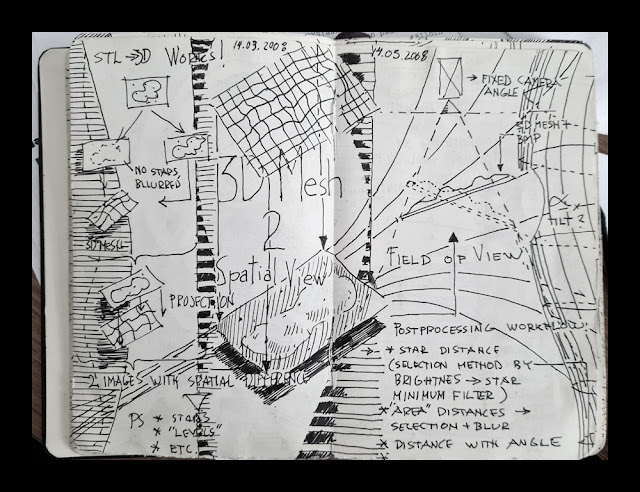 My Moleskine notebook pages from 2008, I planned how to convert nebulae to 3D
My Moleskine notebook pages from 2008, I planned how to convert nebulae to 3D
Monday, October 4, 2021
Three 3D-conversions out of my astronomical photos
I have made dozens of 3D-conversions out of my astronomical photos. As an artist I like to find a new views to the reality. My models are not just a guesswork, the conversion is based on real scientific data.
At the end of this blog post there is a short explanation, how I do my conversion work.
Original astronomical photo about part of the Veil nebula SNR in O-III light only.
3D-study of Veil Nebula Photo
How 3D-models are made My Moleskine notebook pages from 2008, I planned how to convert nebulae to 3D
My Moleskine notebook pages from 2008, I planned how to convert nebulae to 3D
How accurate my 3-D-visions are depending on how much information I have and how well I implement it.
The final 3-D-image is always an appraised simulation of reality based on known scientific facts, deduction, and some artistic creativity.
After I have collected all the necessary scientific information about my target, I start my 3-D conversion from stars. Usually there is a recognizable star cluster which is responsible for ionizing the nebula. We don’t need to know its absolute location since we know its relative location. Stars ionizing the nebula have to be very close to the nebula structure itself. I usually divide up the rest of the stars by their apparent brightness, which can then be used as an indicator of their distances, brighter being closer. If true star distances are available, I use them, but most of the time my rule of thumb is sufficient. By using a scientific estimate of the distance of the Milky Way object, I can locate the correct number of stars in front of it and behind it.
Emission nebulae are not lit up directly by starlight; they are usually way too large for that. Rather, stellar radiation ionizes elements within the gas cloud and the nebula itself is glowing light, the principle is very much the same as in fluorescent tubes. The thickness of the nebula can be estimated from its brightness, since the whole volume of gas is glowing, brighter means thicker.
By this means, forms of the nebula can be turned to a real 3-D shape. Nebulae are also more or less transparent, so we can see both sides of it at the same time, and this makes model-making a little easier since not much is hidden.
The local stellar wind, from the star cluster inside the nebula, shapes the nebula by blowing away the gas around the star cluster. The stellar wind usually forms a kind of cavity in the nebulosity. The same stellar wind also initiates the further collapse of the gas cloud and the birth of the second generation of stars in the nebula. The collapsing gas can resist the stellar wind and produces pillar like formations which must point to a cluster.
Ionized oxygen (O-III) glows with a bluish light, and since oxygen needs a lot of energy to ionize it, this can only be achieved relatively close to the star cluster in the nebula. I use this information to position the O-III area (the bluish glow) at the correct distance relative to the heart of the nebula.
Many other small indicators can be found by carefully studying the image itself. For example, if there is a dark nebula in the image, it must be located in front of the emission one, otherwise we couldn’t see it at all.
Using the known data in this way I build a kind of skeleton model of the nebula. Then the artistic part is mixed with the scientific and logical elements, and after that the rest is very much like creating a sculpture on a cosmic scale
Thursday, September 30, 2021
Filaments of Veil Nebula SNR
I shot most of the lights for this image back in 2016, now I have added some new material to it and reprocessed the whole image. An older mapped color version can be seen here, https://astroanarchy.blogspot.com/2016/12/filaments-of-veil-nebula.html
Photo was shot with a Celestron Edge HD 11" telescope, Astrodon naarrow band filters and Apogee Alta U16 astro camera. New data is shot with a shorter focal length instrument, Tokina AT-x 300mm f2.8 camera lens, same camera and filters. Dim background emission is taken from a new material and added to this photo.
Total exposure time is now 44 hours for the whole three frame mosaic and the resolution is 11.000 x 4000 pixels.
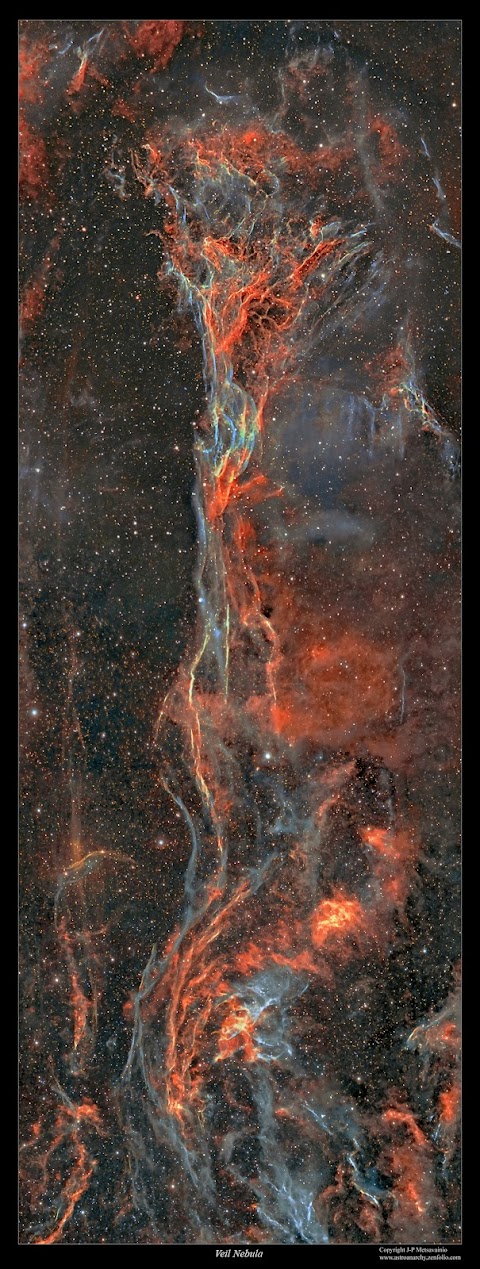
Image is in visual palette from emission of an ionized elements, hydrogen (H-alpha), sulfur (S-II) and oxygen (O-III). Red=Hydrogen + 33% sulfur, Green=oxygen and Blue=oxygen + 33% hydrogen to compensate otherwise missing H-beta emission.
A closeup
Click for a large image
Every single pixel in this 3d-animation is from the original 2D-image above. The model is based on on known scientific facts, deduction and some artistic creativity. The result is an appraised simulation of reality. Astronomical photos are showing objects as paintings on a canvas, totally flat. In reality, they are three dimensional forms floating in three dimensional space. The purpose of my 3d-experiments is to show that and Give an idea, how those distant objects might look in reality. More info about my 3D-technique at end of this blog post: https://astroanarchy.blogspot.com/2021/10/unveiling-veiled.html
NOTE. It looks like that the animation has less stars, than the original 2d-image. That's not true, stars is normal photo are getting projected to a same plane. In 3D-model stars are in volume and it only looks like, that there are less stars.





























